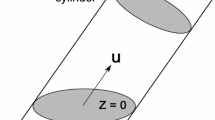Abstract
This paper suggests a high-level continuous image model for planar star-shaped objects. Under this model, a planar object is a stochastic deformation of a star-shaped template. The residual process, describing the difference between the radius-vector function of the template and the object, is allowed to be non-stationary. Stationarity is obtained by a time change. A parametric model for the residual process is suggested and straightforward parameter estimation techniques are developed. The deformable template model makes it possible to detect pathologies as demonstrated by an analysis of a data set of cell nuclei from a benign and a malignant tumour, using stochastic deformations of ellipses.
Similar content being viewed by others
References
A. Fitzgibbon, M. Pilu, and R.B. Fisher, “Direct least square fitting of ellipses,” IEEE Transactions on Pattern Analysis and Machine Intelligence, Vol. 21, pp. 476–480, 1999.
U. Grenander, General Pattern Theory, Oxford University Press: New York, 1993.
U. Grenander and K.M. Manbeck, “A stochastic model for defect detection in potatoes,” Journal of Computer Graphics and Statistics, Vol. 2, pp. 131–151, 1993.
U. Grenander and M.I. Miller, “Representations of knowledge in complex systems (with discussion),” Journal of the Royal Statistical Society, B, Vol. 56, pp. 549–603, 1994.
A. Hobolth and E.B.V. Jensen, “Modelling stochastic changes in curve shape, with an application to cancer diagnostics,” Advances in Applied Probability (SGSA), Vol. 32, pp. 344–362, 2000.
A. Hobolth, J.T. Kent, and I.L. Dryden, “On the relation between edge and vertex modelling in shape analysis,” Scandinavian Journal of Statistics, Vol. 29, pp. 355–374, 2002.
A. Hobolth, J. Pedersen, and E.B.V. Jensen, “A continuous parametric shape model,” Research Report no. 13, Laboratory for Computational Stochastics,University of Aarhus, submitted, 2000.
J.L. Jensen, “A large deviation-type approximation for the “Box class” of likelihood ratio criteria,” Journal of the American Statistical Association, Vol. 86, pp. 437–440, 1991.
N.L. Johnson and S. Kotz, Continuous Univariate Distributions—1, Houghton Mifflin Company: Boston, 1970.
J.T. Kent, I.L. Dryden, and C.R. Anderson, “Using circulant symmetry to model featureless objects,” Biometrika, Vol. 87, pp. 527–544, 2000.
K.V. Mardia and P.E. Jupp, Directional Statistics, Wiley: Chichester, 2000.
L.C.G. Rogers and D. Williams, Diffusions, Markov Processes and Martingales, Vol. 2, Wiley: Chichester, 2000.
H. Rue and M.A. Hurn, “Bayesian object recognition,” Biometrika, Vol. 86, pp. 649–660, 1999.
H. Rue and A.R. Syversveen, “Bayesian object recognition with Baddeley's delta loss,” Advances in Applied Probability (SGSA), Vol. 30, pp. 64–84, 1998.
D. Stoyan and H. Stoyan, Fractals, Random Shapes and Point Fields, Wiley: Chichester, 1994.
C.T. Zahn and R.Z. Roskies, “Fourier descriptors for plane closed curves,” IEEE Transactions on Computers, Vol. 21, pp. 269–281, 1972.
Author information
Authors and Affiliations
Rights and permissions
About this article
Cite this article
Hobolth, A., Pedersen, J. & Jensen, E.B.V. A Deformable Template Model, with Special Reference to Elliptical Templates. Journal of Mathematical Imaging and Vision 17, 131–137 (2002). https://doi.org/10.1023/A:1020681419750
Issue Date:
DOI: https://doi.org/10.1023/A:1020681419750




